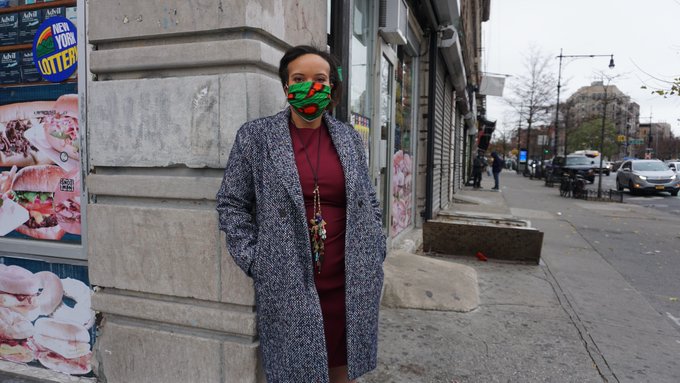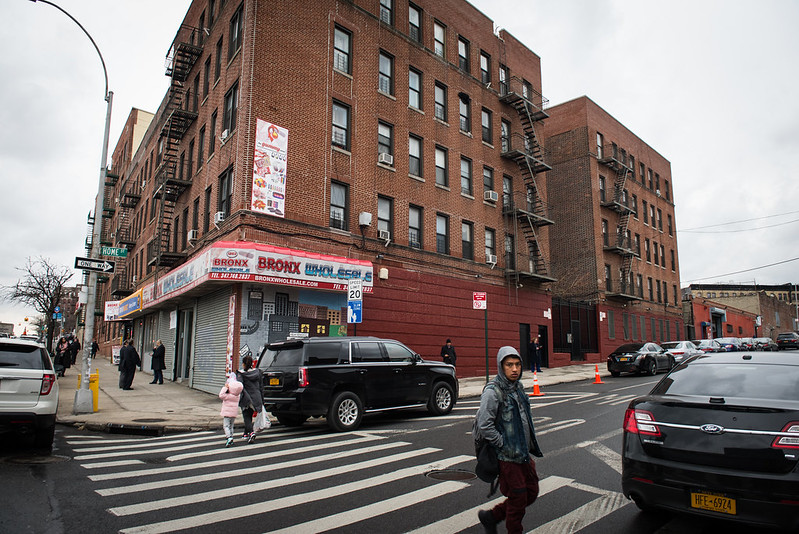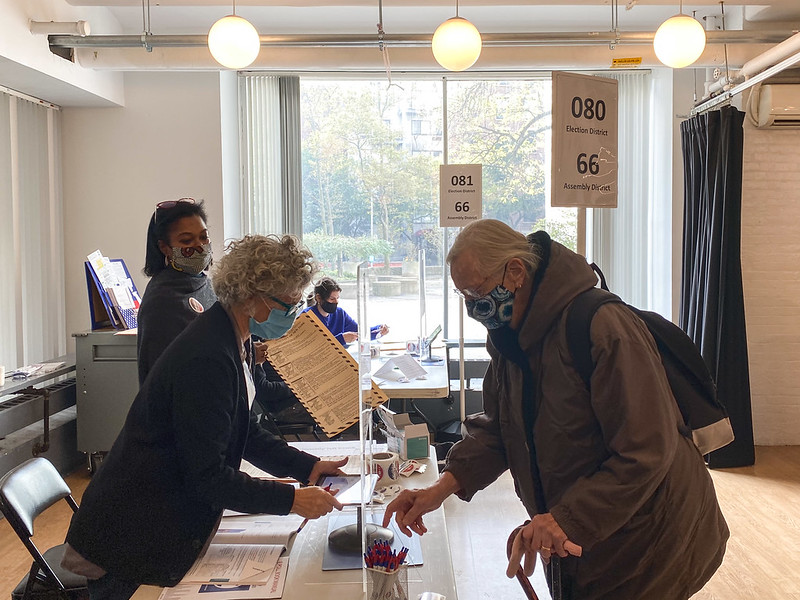Daughters of the Movement, Carrying On

Stacy Lynch, the author (photo: @lynchfornyc7)
Growing up in Harlem as the daughter of Bill Lynch, the mastermind behind David Dinkins’ campaign to become the first Black mayor of New York, public service is in my DNA. Watching him put together coalitions, something he began working with farm workers in the potato fields of eastern Long Island, has stayed with me throughout my career in law and government.
That legacy carries with it the obligation to pay it forward in trying to improve the lives of all of our neighbors. It is why I reached out to the daughters of other pioneering Black activists to work together to create the Daughters of the Movement to build on that legacy.
Working with the daughters and granddaughters of so many of those pioneers – Harry Belafonte, Ossie Davis and Ruby Dee, Percy Sutton, Diahann Carroll, Malcolm X, and Al Sharpton – we have dedicated ourselves to continuing the never-ending struggle towards justice and equality in our city and our nation.
The need for coalition-building has been especially true at this moment, as we struggle with the impact of three devastating crises that individually would be intimidating and together confront us with unprecedented intensity, and which disproportionately affect Black and brown communities in New York City and beyond.
The COVID-19 pandemic, the economic dislocation it has caused with the loss of many thousands of jobs and small businesses, and the struggle for long-overdue racial and economic justice that erupted after the murders of George Floyd, Breonna Taylor, Jacob Blake, and so many others tell us that our ancestors’ struggles are not ancient history but present day reality.
They persist in ways large and small, visible and less visible – the lack of affordable housing, food deserts in vulnerable communities that are linked to high rates of diabetes, environmental racism evident in the groupings of high asthma rates and the location of bus garages and sewage treatment plants, and a digital divide that spans the generations, whether it is students trying to access the internet for remote learning or senior citizens wrestling with trying to register for a COVID-19 vaccine online.
As Daughters of the Movement, we have not been immune to the racism and misogyny that afflicted our foreparents’ efforts to seek justice. In some of our online programming, we have experienced cyberbullying including pornographic, racist, and threatening comments. But we know our foreparents carried on with grace, dignity, and determination in the face of psychological and physical bullying. They would not allow it to dissuade them from the struggle. We too are committed to that legacy of strength and dedication.
We continue to move forward, furthering their legacy and, rather than resting on their laurels, building upon it in a never-ending struggle.
That struggle requires coalition, since together we are stronger than when we stand alone. In my career, whether in law or government, that has meant reaching out to the New York Liberty to create a girls basketball league, working to create internships in the entertainment industry, pressing for the creation of thousands of city-supported summer jobs, or organizing the distribution of masks throughout NYCHA developments during the pandemic.
Growing up as the daughters of pioneers carries its own challenges, which is why in 2017 I first reached out to the daughters of so many of those pioneers who shared the pressures and opportunities our upbringing presented us.
Put simply, I needed a sisterhood.
We have launched a series of podcasts and speakers’ programs across multiple outlets to talk about our experiences and how they relate to developments in politics, the arts, sports, health and, of course, the continuing struggle against racism, injustice, and inequality.
And we talk about the personal aspects of that legacy in ways we hope those who hear us can relate to in their own struggles with growing up and fighting for what is right.
Our parents showed us the way, and we are fighting to open that door wider to welcome all who struggle with us. We’re all in this together.
***
Stacy Lynch, who lives in West Harlem, is running for City Council in Upper Manhattan’s 7th District. On Twitter @lynchfornyc7.
***
Have an op-ed idea or submission for Gotham Gazette? Email This email address is being protected from spambots. You need JavaScript enabled to view it.
Ending the Hierarchy of Homelessness, Getting Everyone Housed

A scene from the Bronx (photo: Edwin J. Torres/Mayoral Photography Office)
The number of military veterans experiencing homelessness in the United States was cut nearly in half between 2010 and 2016, the result of a focus on veterans’ homelessness by the Obama administration.
This focus included: a strategic plan with a clear goal, focused and mandated partnership between government agencies, and the success of the HUD-VA Supportive Housing program, which combines housing support through rental assistance (provided by HUD) with case management and clinical services (provided by the Veterans Administration).
There was also a political dimension. As a member of that administration, I know there was a calculation that veterans were the group of homeless people we thought we could most likely get Republican support for helping. And some Republicans, especially those at the state and local levels, actively engaged. Indeed Utah was one of the states that got veteran homelessness to functionally zero.
Of course, the intent and hope by the Obama administration was to prove what was possible with veterans and then be able to use those methods with other groups of homeless people. No one who has served our country should be on the streets, or in a shelter. Indeed no one at all should be living on the streets, or in a shelter.
That expansion of proven models from veterans to other homeless populations certainly didn’t happen under the Trump administration and now COVID-19 has had a devastating impact on housing security and care for the homeless. The true extent may not be known for a while. The annual point in time count of the number of homeless people nationwide takes place every January and with social distancing it’s hard to know how accurate the 2021 count can be.
As we look to recover from covid, with a new administration in Washington and a new mayor to be elected in New York City this year, it is time to think differently and holistically. While different homeless populations have different needs, we cannot afford to move incrementally population by population. It’s time to disrupt the hierarchy of homelessness. We must redouble our efforts to house veterans and we must not leave any homeless person behind, whether the formerly incarcerated, or the often hidden family homeless population.
And we can do that because much of what was done right with reducing veteran homelessness can be applied more broadly. We already know what works.
As mentioned, it started with a strategic plan with a clear goal: Opening Doors: The Federal Strategic Plan to Prevent and End Homelessness. In New York City we now have a blueprint: the United For Housing report From The Ground Up, with recommendations for the next mayor. This report was put together by a coalition of more than 80 organizations across a broad political spectrum, including my Trinity Church Wall Street colleague Bea de la Torre, who leads our work to end mass homelessness. From the Ground Up anchors combatting homelessness in a broader strategy to fund and build racial equity and more affordable housing, as well as identifying specific approaches for reducing – and in particular preventing - homelessness.
Second, the work to reduce veteran homelessness required active partnership between government agencies. The United States Interagency Council on Homelessness (USICH) coordinated the Opening Doors plan. The Council brought together 19 Cabinet Secretaries and agency heads to coordinate the federal response to homelessness. And indeed, at the city level, the first recommendation on combating homelessness from United for Housing is to empower a single Deputy Mayor for Housing Opportunity & Economic Development “in order to link historically distinct City departments under singular leadership for greater accountability and consistency.” Those agencies will all require clear – and connected – goals to play their part.
The third component of addressing homelessness among veterans was the success of the HUD-VA Supportive Housing program. Supportive housing combines affordable housing with wrap-around services. We know it works and the next mayor must commit to an ambitious target of at least 2,000 new supportive housing units per year as part of a much larger target of more affordable housing. We must also think creatively about how to realize the goals. For example, how can near-empty hotels be repurposed for supportive housing units?
Finally, to connect together all the proven models and good ideas the next mayor should commit to a right to housing. The current right to shelter, while an important safety net, is more band-aid than solution. President Biden has committed to a national strategy to make housing a right for all and New York City should be a leader in that strategy. The need for a safe and secure place to spend the night and base our lives is universal. There should be no hierarchy in helping the homeless.
***
Neill Coleman is the Chief Philanthropy Officer at Trinity Church Wall Street and was the Chief External Affairs Officer at HUD during the Obama administration. On Twitter @neillcoleman & @TrinityWallSt.
***
Have an op-ed idea or submission for Gotham Gazette? Email This email address is being protected from spambots. You need JavaScript enabled to view it.
It’s Time for a Really Robust Ranked-Choice Voting Education Effort

Voting (photo: Michael Appleton/Mayoral Photography Office)
Voting is the backbone of our democracy, and should reflect the will of the people. That is the idea behind New York City’s 2019 vote, in which 73% of voters supported a ballot question changing our electoral process from a single choice plurality voting to a new system, known as ranked-choice voting (RCV). Following the lead of cities like Minneapolis and San Francisco, voters decided it was time to change the way we select the leaders in our local government.
In party primary and special elections for city government positions, RCV allows voters to rank up to five candidates by order of preference. If no candidate receives a majority of first-place votes, the candidate in last place is eliminated and that candidate’s votes are redistributed based on those voters’ second choices. The process continues until a candidate receives an outright majority.
According to proponents of the new system, there are many benefits, including ensuring that winners have broader support, discouraging negative campaigning, and avoiding costly run-off elections. But in addition to reflecting the will of the people, it must also be easy and accessible, and there are strong concerns about the timing of implementation and the ability of our New York City Campaign Finance Board (CFB) to properly inform voters of this new change to how they will be electing their representatives.
In the first special election this year, in Queens’ City Council District 24, a candidate received a majority of first-place votes, negating the opportunity to see ranked-choice voting in action. When I speak to voters about the upcoming City Council special election here in the Northwest Bronx, in which I am running, it is clear that many do not know about the shift to ranked-choice voting, and even those who vote in every election are unfamiliar with the concept. This is deeply concerning, as the democratic promise of RCV relies on an informed and educated electorate.
But due to a lack of outreach and education on the part of the CFB, which is tasked with those responsibilities by the RCV law, it is likely that voters may end up selecting their top choice while leaving other choices blank, which could effectively disenfranchise those voters and leave them without the voice they were promised when these reforms were made. This is not the intention of these reforms, and if we want to fully embrace the new system, widespread education must be implemented by the CFB. Even worse, voters may end up invalidating their ballots due to errors. I was very troubled to learn that while there are opportunities for those voting in person to fix ballot errors, there is no ballot curing process for voters who vote by mail and vote for more than one candidate in the same ranking, or “over-vote” — a mistake that we can predict and address if we take action now.
As New Yorkers, we like to think that our city government reflects our progressive values. However, the most vulnerable residents in our city have always been left behind, and we often fail to get resources to those who need it the most. We saw this happen in last year’s elections, where problems with absentee ballots disproportionately negatively impacted seniors and people with disabilities, and in the middle of a pandemic forced voters to choose between their health and casting their vote. Without proper education, the new ranked-choice voting system has the potential to disenfranchise voters who are historically overlooked, including immigrants, people of color, and older adults.
The CFB’s actions to reach voters are insufficient. It is currently hosting RCV education webinars, but they are not widely publicized or advertised to the general public. To try to supplement these, the CFB has also enlisted community groups to conduct RCV workshops for voters. This means that a voter’s opportunity to learn about the new system can depend on the enterprise of their local community organizations, and whether or not residents are plugged in to those organizations. We are already seeing more of these workshops taking place in white, affluent parts of our city, often for younger or more technologically-adept individuals. The pandemic has shone a light on the digital divide that affects our communities with inadequate access to the internet, which is crucial to attending these trainings amid a pandemic. Furthermore, there appears to be little effort to target non-English speakers, making language access yet another barrier for RCV education.
I am dismayed by the thought of voters being confused while they fill out their ballots. The CFB must increase its efforts to run a robust public education campaign immediately. Our city must immediately expand community outreach, and provide education on TV, digital platforms, and radio. RCV information should already be posted on the almost 2,000 LinkNYC kiosks across the city. We should also advertise on our subways platforms and bus stops. We should incorporate RCV education into social services, such as meal delivery to seniors. This education campaign must extend to every neighborhood in our city, with dedicated resources for inclusive language access.
I have fought to expand access to early voting and mail-in balloting, and to make the process of voting easier and accessible for all New Yorkers, including non-English speakers and people with disabilities. The rollout of RCV still leaves many questions unanswered, which threatens to disenfranchise wide groups of voters. Our seniors, who have been voting the same way their entire lives, now must contend with this new system without sufficient education. It is not beyond the capability of the CFB to do this right. If we don’t get serious about ranked-choice voting education for our city’s voters, the very communities that need the most support during this pandemic will once again be voiceless.
***
Eric Dinowitz is a candidate for City Council in the District 11 special election taking place on March 23 in the Bronx. On Twitter @EricDinowitz.
***
Have an op-ed idea or submission for Gotham Gazette? Email This email address is being protected from spambots. You need JavaScript enabled to view it.




